
Crises forces, and also creates opportunity for, change! The COVID-19 pandemic compelled campus classes online, but many faculty simply moved their lectures to online platforms. They did not understand that teaching online is a totally different educational paradigm! The result is that, sadly, many classes are judged as unengaging and the content difficult to learn by students.
While online education is an established and growing trend, the pandemic has changed education forever, resulting in what could become a permanent shift away from classroom instruction in favor of virtual learning platforms. However, this is only the case if classes are designed using a blended model as discussed in the September[1] article “Blended Learning Classroom Guidance.” This focuses on increasing student engagement through active learning.
“Research has demonstrated that engaging students in the learning process increases their attention and focus, motivates them to practice higher-level critical thinking skills, and promotes meaningful learning experiences. Instructors who adopt a student-centered approach to instruction increase opportunities for student engagement, which then helps everyone more successfully achieve the course’s learning objectives”. [2]
For those questioning whether the continued adoption of virtual learning platforms can deliver the same educational value to students as in-person learning, I’m sharing my thoughts about an online teaching and learning platform called Yellowdig. The University of Maryland Center for Project Management launched a beta test of Yellowdig in the fall 2020 semester, to establish whether this platform could be used to promote the creation of engaged learning communities in our online courses.
What is Yellowdig? ![]()
Yellowdig is a virtual collaborative teaching and learning application that allows students to share relevant sources on class topics. It can be as dynamic and as engaging as the other social media platforms students use in their personal lives.
Students are incentivized by receiving points for their participation, based on the quality of their posted content. Peer interaction, both in and out of class time, is encouraged through Yellowdig’s community-building tools. The platform allows professors to track students’ engagement and participation plus share content.
Ensuring “social distance” doesn’t become “social isolation”
Research tells us that the more a student in an online classroom environment participates and engages with the course content, the professor and their fellow students, the less likely it is that they’ll drop the course. In fact, they’ll probably finish the course with a strong sense that their invested time, effort and tuition money were as worthwhile as their in-person classes.
We’ve seen that increased student engagement also means improved retention of the content covered in the course. The “gamified” point system used in Yellowdig encourages students to initiate content and comment on each other’s posts, resulting in an increased level of student engagement with the topics through worthwhile peer-to-peer interactions.
Encouraging student participation in a traditional classroom setting can be difficult enough. During a pandemic, with safety restrictions making face-to-face interaction nearly impossible, we searched for ways to evolve from class participation to class engagement in our online courses.
The drive to experiment with this was simply that we believe our online courses already have an above average degree of engagement between students and faculty. Under the circumstances due to the extended quarantine, we were looking to see if we could get better, and we thought this discussion tool might be the way to do it.
So, the goal of the beta test was to find out if we were right. Does Yellowdig actually help to achieve a higher level of learning engagement than other online platforms that are commonly used for theory and practice integration?
Survey responses
Our Yellowdig beta testing experiment included six faculty volunteer participants; three each teaching undergraduate and graduate courses, as well as their 241 combined students, whom we surveyed for their responses to their experience with Yellowdig.
Professors were asked specifics about how they used Yellowdig in their course, and to describe the lessons they learned after using the tool during the semester. Overall, they reported having a very positive experience using Yellowdig as a teaching tool, defining “success” with the platform as follows:
- Success with this tool is a function of how the professor embraces it as part of the learning paradigm.
- The professor should think of themselves as the senior member of a learning community.
- The professor should model the behavior they want the students to emulate.
- Instructor needs to set constraints at the beginning as to what is appropriate content to post.
- Instructor needs to explain the effective use of Yellowdig and set a clear understanding of how to use it.
- The professor should devote time during each weekly Zoom session for students to discuss postings that resonated with them.
- The combination of Yellowdig and Zoom seem to ignite a higher level of self-directed learning among the class, with everyone participating.
- Whatever is posted in Yellowdig should not be available in any other location.
- Assess, improvise and adjust. Professors need to be open to making changes throughout the semester to stimulate discussions.
- Adjust participation points accordingly throughout the semester. Read all posts and award accolades or deduct points as necessary, and keep a keen eye out for students who are trying to game the point system.
- Start on a Friday and make the weekend the beginning of the period, not the end.
- Yellowdig should be integrated into the course LMS, not function as a standalone system.
- There’s a strong correlation between Yellowdig participation and final course grade.
- Designate a few weeks during the semester for students to discuss case studies in the Yellowdig community.
Some negative comments from professors focused on the fact that on occasion, students’ posts were irrelevant to the topic, and since it was a grade-driven activity based on the frequency of participation, it was sometimes difficult to ensure the quality of the posts. This can be managed, however, by setting clear expectations and also taking away points automatically assigned by Yellowdig for student posts that are irrelevant or filler simply to gain points.
Still, five out of the six professors who volunteered to beta test this tool said that they would continue using it.
What do the students think about Yellowdig?
The 241 surveyed students also gave their feedback on their experiences learning with the tool, as well as offering other insights.
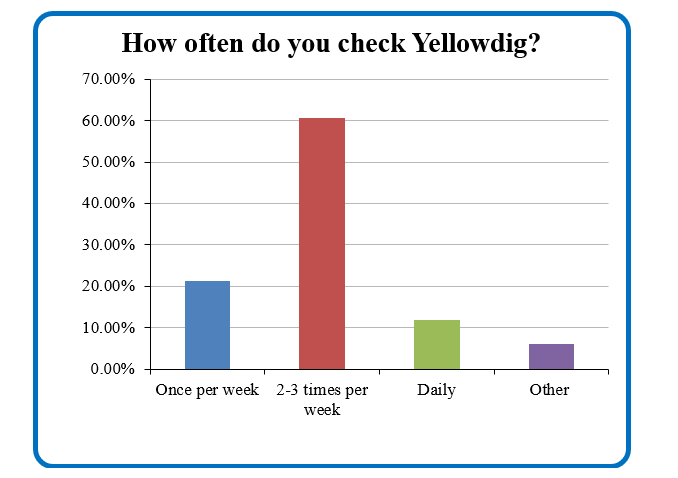
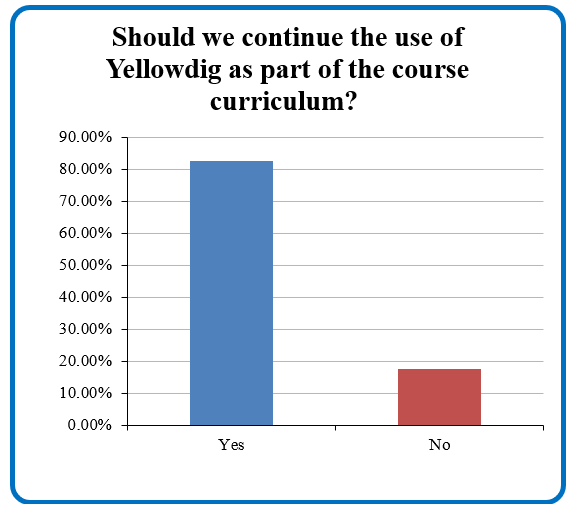
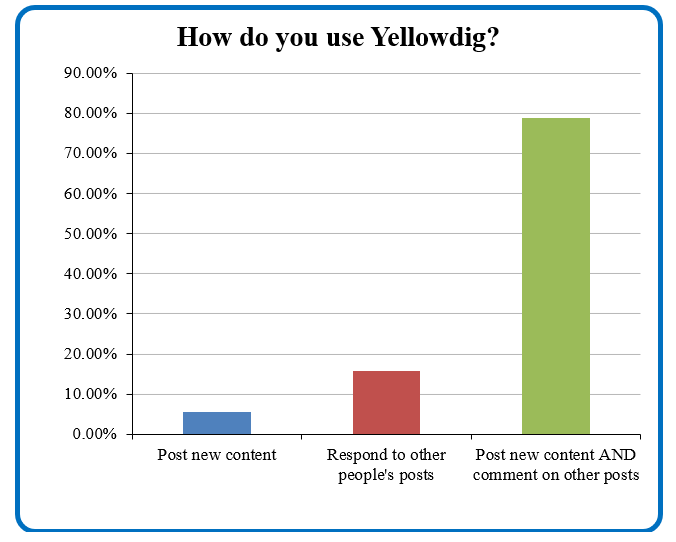
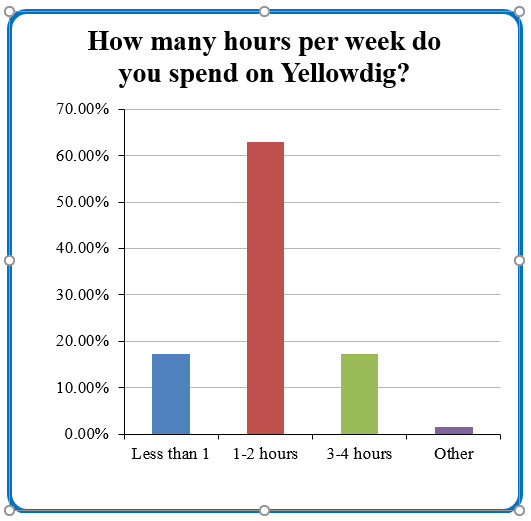
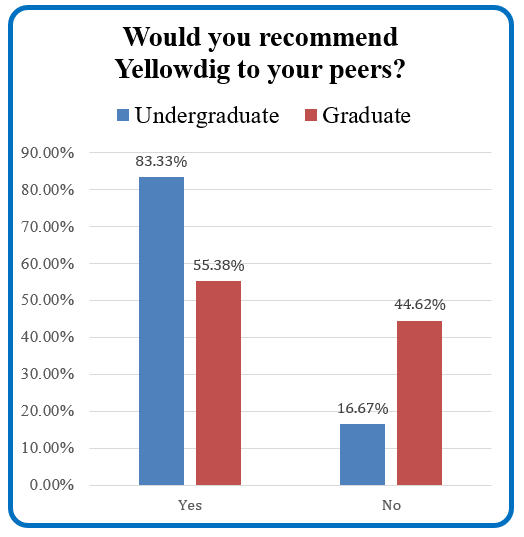
Students surveyed offered feedback about what they liked and disliked about Yellowdig, and how using the platform supported (or didn’t support) their learning. Generally, their responses were positive, as follows:
- It helped me process class information better, since I could see what my classmates were learning. It allowed my classmates to give me help and support when I needed it, and it gave a feeling of closure with that week’s class material.
- It created a sense of community and I was able to ask questions when confused.
- It helped maintain a more typical university experience that online classes due to COVID have drastically taken away from students. While there is no virtual replacement that comes close to an in-class experience, this was nice to have.
- It allowed seeing how the context of the class can be applied to the real world. It has allowed for the outside class conversation to arise.
- I think it’s a good way to get a class participation grade and it’s a good way to stay connected to the class.
- I think it enhances student involvement and allows people to learn from not only the professor, but from other students.
- Yellowdig is the most interactive platform I’ve used so far, especially in a purely virtual environment. It also gives students a good opportunity to get a different perspective on certain topics.
- I liked being able to build a sense of community, even though the course was fully online. I really liked the way Yellowdig tracked your word counts and your points for the week and the whole semester.
- This has really allowed me to make connections from the class topics into real life. I look for ways I can interestingly related content to the real world, allowing for applications to be made that I normally wouldn’t think of, and it helped me have a feeling of a class bond that would have been there with simply a virtual classroom.
- Yellowdig helped further discussions about what we read in class in the assigned readings, which we didn’t always get to discuss in class.
- Yellowdig was far superior to other discussion board assignments I have had in other classes.
- I think it was neat to access the multitude of resources and links that students post by scrolling through a feed.
Students with less favorable feedback cited that the point quota for posts was too high, and that some posts were irrelevant, misleading, or did not provide valuable information. Some felt that it often became too difficult to keep track and stay engaged with the content as frequently as expected, and that using the platform didn’t feel as “organic” as it had been portrayed at the beginning of the semester.
Final thoughts on Yellowdig
Three of the six professors surveyed said that they had integrated Yellowdig into how they taught their classes, and they believed it had a direct, positive impact on student success. They all agreed that if Yellowdig’s capabilities aren’t integrated into the course paradigm, then it’s just another platform and the benefits are few.
Our Yellowdig beta testing experiment has demonstrated that overall, the platform was a useful and enriching teaching and learning tool if the professor embraces it as part of the learning paradigm. In a virtual learning environment where promoting interaction and engagement is a real challenge, this platform can provide the “missing link” that restores the sharing and collaborative elements that were present in the in-person classroom as long as you heed the lessons learned shown above to ensure the success of the implementation.
This article appeared in PM World Journal, Vol. X, Issue II, February 20201.

John Cable, Director, Project Management Center for Excellence, University of Maryland
How to cite this article: Cable, J. H. (2021). Converting to Online Teaching: A Series of short guidance articles for educators and institutions – Do You MOOC?, PM World Journal, Vol. X, Issue II, February.
References:
[1] Cable, J. H. (2020). Converting to Online Teaching: A series of short guidance articles for educators and institutions – Blended Learning Classroom Guidance, PM World Journal, Vol. IX, Issue IX, September.
[2] University of Washington Center for Teaching and Learning, see https://teaching.washington.edu/topics/engaging-students-in-learning/#:~:text=Research%20has%20demonstrated%20that%20engaging,and%20promotes%20meaningful%20learning%20experiences
Posted by Kathy Frankle on February 10, 2021

 Data Analytics for the Project Manager
Data Analytics for the Project Manager